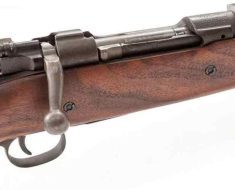“Action Repairs: Keeping Your Firearms Cycling Smoothly”
Benefits of Regular Maintenance for Bolt-Action Rifles
Regular maintenance is essential for keeping your bolt-action rifle in top condition. By taking the time to clean and lubricate your firearm, you can ensure that it functions smoothly and reliably every time you pull the trigger. In this article, we will discuss the benefits of regular maintenance for bolt-action rifles and provide some tips on how to keep your firearm in optimal working order.
One of the primary benefits of regular maintenance is that it helps prevent malfunctions and jams. Over time, dirt, debris, and fouling can build up in the action of your rifle, causing it to cycle less smoothly. By regularly cleaning and lubricating your firearm, you can remove these contaminants and ensure that your bolt-action rifle operates as intended.
Regular maintenance also helps extend the life of your rifle. By keeping your firearm clean and well-lubricated, you can prevent wear and tear on the moving parts of the action. This can help prolong the lifespan of your rifle and ensure that it continues to perform reliably for years to come.
In addition to preventing malfunctions and extending the life of your rifle, regular maintenance can also improve the accuracy of your shots. A clean and well-maintained action will cycle more smoothly, allowing you to take more consistent and precise shots. By taking the time to clean and lubricate your bolt-action rifle regularly, you can ensure that it performs at its best every time you take it to the range or out into the field.
To keep your bolt-action rifle in optimal working order, it is important to follow a regular maintenance routine. Start by disassembling your firearm and inspecting the action for any signs of dirt, debris, or fouling. Use a cleaning rod and brush to remove any contaminants from the action, barrel, and other components of your rifle.
After cleaning your rifle, be sure to lubricate the moving parts of the action with a high-quality gun oil. This will help reduce friction between the components of your firearm and ensure that it cycles smoothly. Be sure to use only a small amount of oil, as too much can attract dirt and debris and cause malfunctions.
In addition to cleaning and lubricating your rifle, it is also important to inspect and replace any worn or damaged parts. Check the springs, pins, and other components of your bolt-action rifle for signs of wear and tear, and replace them as needed. By keeping your firearm in good repair, you can prevent malfunctions and ensure that it continues to perform reliably.
In conclusion, regular maintenance is essential for keeping your bolt-action rifle in top condition. By cleaning, lubricating, and inspecting your firearm regularly, you can prevent malfunctions, extend its lifespan, and improve its accuracy. Take the time to care for your rifle, and it will reward you with years of reliable performance in the field.
Troubleshooting Common Cycling Issues in Lever-Action Firearms
If you own a lever-action firearm, you know how important it is to keep it cycling smoothly. Whether you use your gun for hunting, target shooting, or just for fun at the range, a properly functioning firearm is essential. However, like any mechanical device, lever-action firearms can experience cycling issues from time to time. In this article, we will discuss some common cycling issues that you may encounter with your lever-action firearm and provide some tips on how to troubleshoot and resolve them.
One of the most common cycling issues that lever-action firearms experience is failure to feed. This occurs when the next round in the magazine does not properly feed into the chamber after the previous round has been fired. This can be caused by a variety of factors, including a dirty or damaged magazine, a weak magazine spring, or an improperly adjusted feed ramp. To troubleshoot this issue, start by cleaning and inspecting the magazine for any dirt, debris, or damage. If the magazine appears to be in good condition, check the magazine spring to ensure that it is not worn or damaged. If the magazine and spring are both in good condition, you may need to adjust the feed ramp to ensure that it is properly guiding the rounds into the chamber.
Another common cycling issue that lever-action firearms experience is failure to eject. This occurs when the spent casing does not properly eject from the chamber after the round has been fired. This can be caused by a variety of factors, including a dirty or damaged extractor, a weak extractor spring, or an improperly adjusted ejector. To troubleshoot this issue, start by cleaning and inspecting the extractor for any dirt, debris, or damage. If the extractor appears to be in good condition, check the extractor spring to ensure that it is not worn or damaged. If the extractor and spring are both in good condition, you may need to adjust the ejector to ensure that it is properly ejecting the spent casings from the chamber.
One final common cycling issue that lever-action firearms experience is failure to cycle. This occurs when the action of the firearm does not properly cycle after the round has been fired. This can be caused by a variety of factors, including a dirty or damaged action, a weak action spring, or an improperly lubricated action. To troubleshoot this issue, start by cleaning and inspecting the action for any dirt, debris, or damage. If the action appears to be in good condition, check the action spring to ensure that it is not worn or damaged. If the action spring is in good condition, you may need to lubricate the action to ensure that it cycles smoothly.
In conclusion, keeping your lever-action firearm cycling smoothly is essential for optimal performance. By understanding and troubleshooting common cycling issues, you can ensure that your firearm functions reliably every time you pull the trigger. Remember to regularly clean and inspect your firearm, and address any issues promptly to prevent further damage. With proper maintenance and care, your lever-action firearm will provide you with years of reliable service and enjoyment.
Tips for Cleaning and Lubricating Semi-Automatic Pistols
When it comes to maintaining your semi-automatic pistol, regular cleaning and lubrication are essential to ensure smooth cycling and reliable performance. Neglecting these tasks can lead to malfunctions, misfires, and even damage to your firearm. In this article, we will provide you with some tips on how to properly clean and lubricate your semi-automatic pistol to keep it in top condition.
First and foremost, before you begin cleaning your pistol, always make sure it is unloaded. Remove the magazine and visually inspect the chamber to ensure there is no round present. Safety should always be your top priority when handling firearms.
To start the cleaning process, disassemble your pistol according to the manufacturer’s instructions. This typically involves removing the slide, barrel, recoil spring, and guide rod. Once disassembled, use a cleaning rod and patch to run a solvent-soaked patch through the barrel to remove any fouling or debris. Be sure to also clean the slide, frame, and other components of the pistol with a solvent-soaked brush or patch.
After cleaning, it is important to thoroughly dry all components to prevent rust and corrosion. Use a clean, dry patch to remove any excess solvent or moisture. Once dry, it is time to lubricate your pistol. Proper lubrication is crucial to ensure smooth cycling and reduce wear on moving parts.
When lubricating your pistol, it is important to use a high-quality gun oil or grease specifically designed for firearms. Apply a small amount of lubricant to key areas such as the slide rails, barrel hood, and locking lugs. Be sure not to over-lubricate, as excess oil or grease can attract dirt and debris, leading to malfunctions.
After lubricating, reassemble your pistol according to the manufacturer’s instructions. Cycle the slide several times to distribute the lubricant evenly and ensure smooth operation. Finally, perform a function check to ensure everything is working properly before storing your pistol.
In addition to regular cleaning and lubrication, it is also important to inspect your pistol for any signs of wear or damage. Check for worn or damaged parts such as springs, pins, or extractor. If you notice any issues, it is best to have your pistol inspected by a qualified gunsmith to prevent further damage or malfunctions.
In conclusion, proper cleaning and lubrication are essential for maintaining your semi-automatic pistol and ensuring reliable performance. By following these tips and regularly maintaining your firearm, you can keep your pistol cycling smoothly and extend its lifespan. Remember, safety should always be your top priority when handling firearms. So, take the time to properly clean and lubricate your pistol to keep it in top condition for years to come.
Upgrading Components to Improve Cycling Performance
If you’re a firearms enthusiast, you know how important it is to keep your bolt, lever, or semi-auto cycling smoothly. A well-maintained firearm not only performs better but also ensures your safety while shooting. One way to improve the cycling performance of your firearm is by upgrading its components. In this article, we’ll discuss some key components that you can upgrade to keep your firearm running smoothly.
One of the most critical components of a firearm is the bolt. The bolt is responsible for chambering a round, locking the breech, and extracting and ejecting the spent casing. Upgrading your bolt to a high-quality, precision-machined bolt can significantly improve the cycling performance of your firearm. A well-made bolt will ensure smooth operation and reduce the risk of malfunctions.
Another important component to consider upgrading is the lever. The lever is used to cycle the action of a lever-action firearm, such as a lever-action rifle or shotgun. Upgrading your lever to a smoother, more ergonomic design can make cycling your firearm easier and more comfortable. A high-quality lever will also reduce the amount of force required to cycle the action, making shooting more enjoyable.
For semi-automatic firearms, upgrading the action components can greatly improve cycling performance. One key component to consider upgrading is the recoil spring. A high-quality recoil spring will help absorb recoil and ensure smooth cycling of the action. Additionally, upgrading the trigger assembly can improve the overall feel and performance of your firearm. A crisp, clean trigger pull can make shooting more accurate and enjoyable.
When upgrading components on your firearm, it’s essential to choose high-quality, precision-machined parts from reputable manufacturers. Cheap, poorly-made components can cause malfunctions and reduce the reliability of your firearm. By investing in quality components, you can ensure that your firearm will perform at its best and last for years to come.
In conclusion, upgrading components on your bolt, lever, or semi-auto firearm can greatly improve its cycling performance. By investing in high-quality, precision-machined parts, you can ensure that your firearm will operate smoothly and reliably. Whether you’re a competitive shooter or a casual gun enthusiast, keeping your firearm in top condition is essential for safety and performance. So why not take the time to upgrade your components and enjoy a smoother shooting experience? Your firearm will thank you for it.
How to Properly Store and Transport Your Action Repairs Firearms
Properly storing and transporting your action repairs firearms is essential to ensuring they remain in top working condition. Whether you have a bolt-action, lever-action, or semi-automatic firearm, taking the necessary precautions will help prevent damage and keep your gun cycling smoothly.
When it comes to storing your firearms, the first step is to invest in a quality gun safe. A gun safe not only provides security for your firearms but also protects them from environmental factors such as humidity and temperature fluctuations. Make sure to choose a safe that is large enough to accommodate your firearms and any accessories you may have.
Once you have a gun safe, it’s important to properly clean and lubricate your firearms before storing them. This will help prevent rust and corrosion, which can damage the internal components of your gun. Use a cleaning kit specifically designed for firearms and follow the manufacturer’s instructions for proper maintenance.
When storing your firearms in the gun safe, make sure they are unloaded and the ammunition is stored separately. This will help prevent accidents and ensure the safety of those around you. Additionally, consider using a dehumidifier or silica gel packs to help control moisture levels inside the safe.
When it comes to transporting your firearms, there are a few key things to keep in mind. First and foremost, always transport your firearms in a locked case or gun bag. This will help prevent theft and ensure the safety of those around you. Make sure the case or bag is padded to protect your firearms from bumps and jostling during transport.
If you are traveling with your firearms, be sure to check the laws and regulations of the area you will be visiting. Some states have strict gun laws that may require you to obtain a permit or license before bringing your firearms into the state. It’s always better to be safe than sorry, so do your research ahead of time to avoid any legal issues.
When transporting your firearms in a vehicle, always make sure they are unloaded and the ammunition is stored separately. Keep your firearms out of sight and locked in the trunk or a secure compartment to prevent theft. If you are traveling long distances, consider investing in a gun rack or lockable gun case to secure your firearms inside the vehicle.
In conclusion, properly storing and transporting your action repairs firearms is crucial to keeping them in top working condition. By investing in a quality gun safe, cleaning and lubricating your firearms regularly, and following proper safety precautions when transporting your firearms, you can ensure they remain in excellent shape for years to come. Remember to always follow the manufacturer’s instructions and local laws when handling your firearms to prevent accidents and legal issues.





